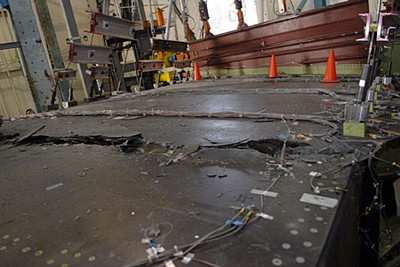Sun, Nov 16, 2008
Must Withstand Forces Up To 1.5 Times Of Highest Expected
Load
Boeing completed destructive testing Saturday on a full-scale
composite wing box of the 787 Dreamliner, the first all-composite
wing box ever built for a Boeing commercial airplane. This test is
part of the certification process for the all-new jetliner.

"Successful completion of the wing box destruction test marks a
major step forward in highlighting the innovation on the 787," said
Mark Jenks, vice president of 787 Development. "In addition to
determining the strength of the structure, the test helps us verify
the analytical methods we have used to calculate the loads the
structure will have to carry."
The wing box is a cantilevered beam that carries the wing to the
fuselage and supports leading- and trailing-edge devices, control
surfaces, engines and landing gear. The test piece represents a
portion of the wing section that begins at about the center of the
airplane and stops at approximately one-half of the span of the
wing -- approximately 50 feet. The piece measures approximately 18
feet at its widest point.
The upper and lower surface panels and the spars of the wing are
made entirely of the same composite material being used on the
fuselage. The wing ribs are monolithic aluminum structures, each
machined from a single piece of aluminum plate.
To meet certification requirements, the wings must withstand
loads up to 1.5 times, or 150 percent, of the highest aerodynamic
load that the jet could ever be expected to see in the entire
lifetime of the 787 fleet.
The test wing box weighs 55,000 pounds, including a great deal
of test-only hardware and instrumentation. It was designed and
built by a joint team of Boeing, Mitsubishi Heavy Industries and
Fuji Heavy Industries.
Structural testing will continue on two full-scale 787 airframes
as part of the certification process for the airplane. Those tests
will further demonstrate the performance of the structure through
multiple lifetimes of normal operational loads and test the
structure beyond the points expected to be seen in service.
More News
Aero Linx: Model Aeronautical Association of Australia MAAA clubs are about fun flying, camaraderie and community. For over 75 years, the MAAA has been Australia’s largest fl>[...]
Touchdown Zone Lighting Two rows of transverse light bars located symmetrically about the runway centerline normally at 100 foot intervals. The basic system extends 3,000 feet alon>[...]
“Discovery and innovation are central to our mission at Virgin Galactic. We’re excited to build on our successful record of facilitating scientific experiments in subor>[...]
How To Get A Story On Aero-TV News/Feature Programming How do I submit a story idea or lead to Aero-TV? If you would like to submit a story idea or lead, please contact Jim Campbel>[...]
Student Pilot Reported That During Rotation, “All Of A Sudden The Back Of The Plane Kicked To The Right..." Analysis: The student pilot reported that during rotation, “>[...]
 ANN's Daily Aero-Linx (05.02.24)
ANN's Daily Aero-Linx (05.02.24) ANN's Daily Aero-Term (05.02.24): Touchdown Zone Lighting
ANN's Daily Aero-Term (05.02.24): Touchdown Zone Lighting Aero-News: Quote of the Day (05.02.24)
Aero-News: Quote of the Day (05.02.24) ANN FAQ: Contributing To Aero-TV
ANN FAQ: Contributing To Aero-TV NTSB Final Report: Cirrus Design Corp SR20
NTSB Final Report: Cirrus Design Corp SR20



